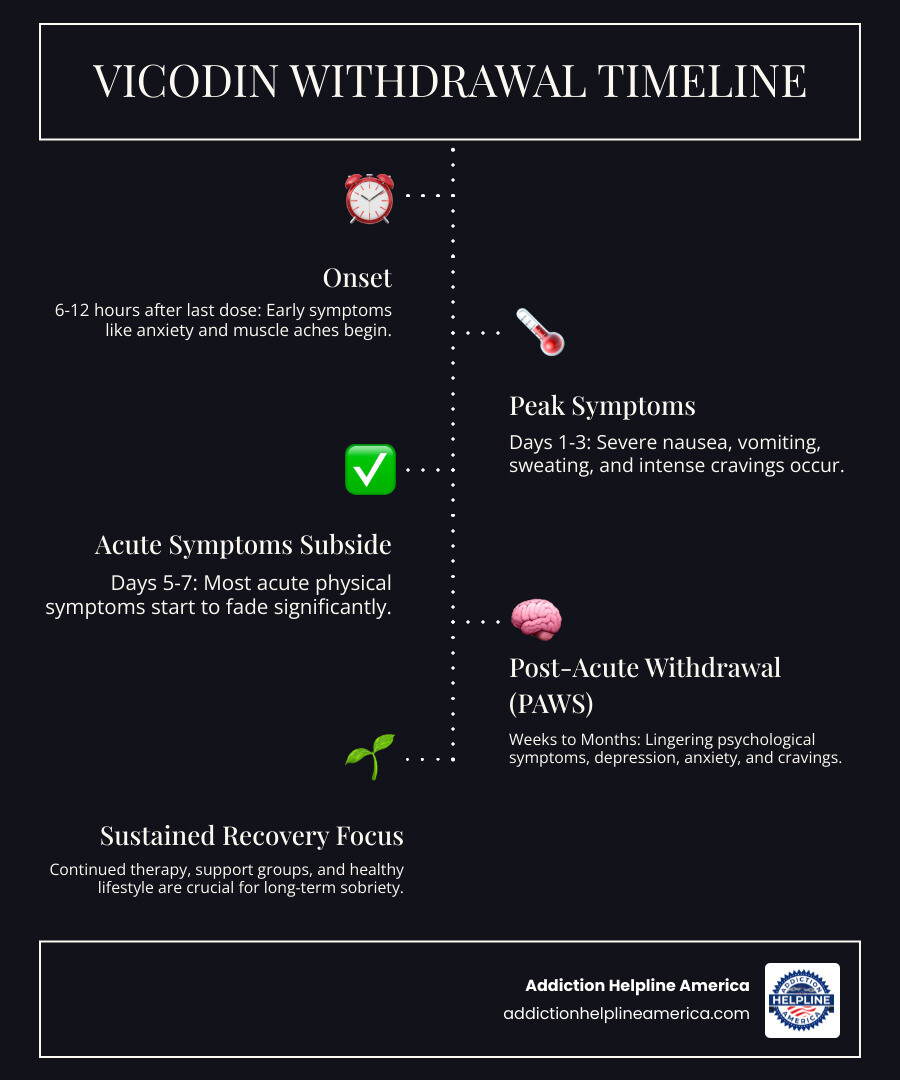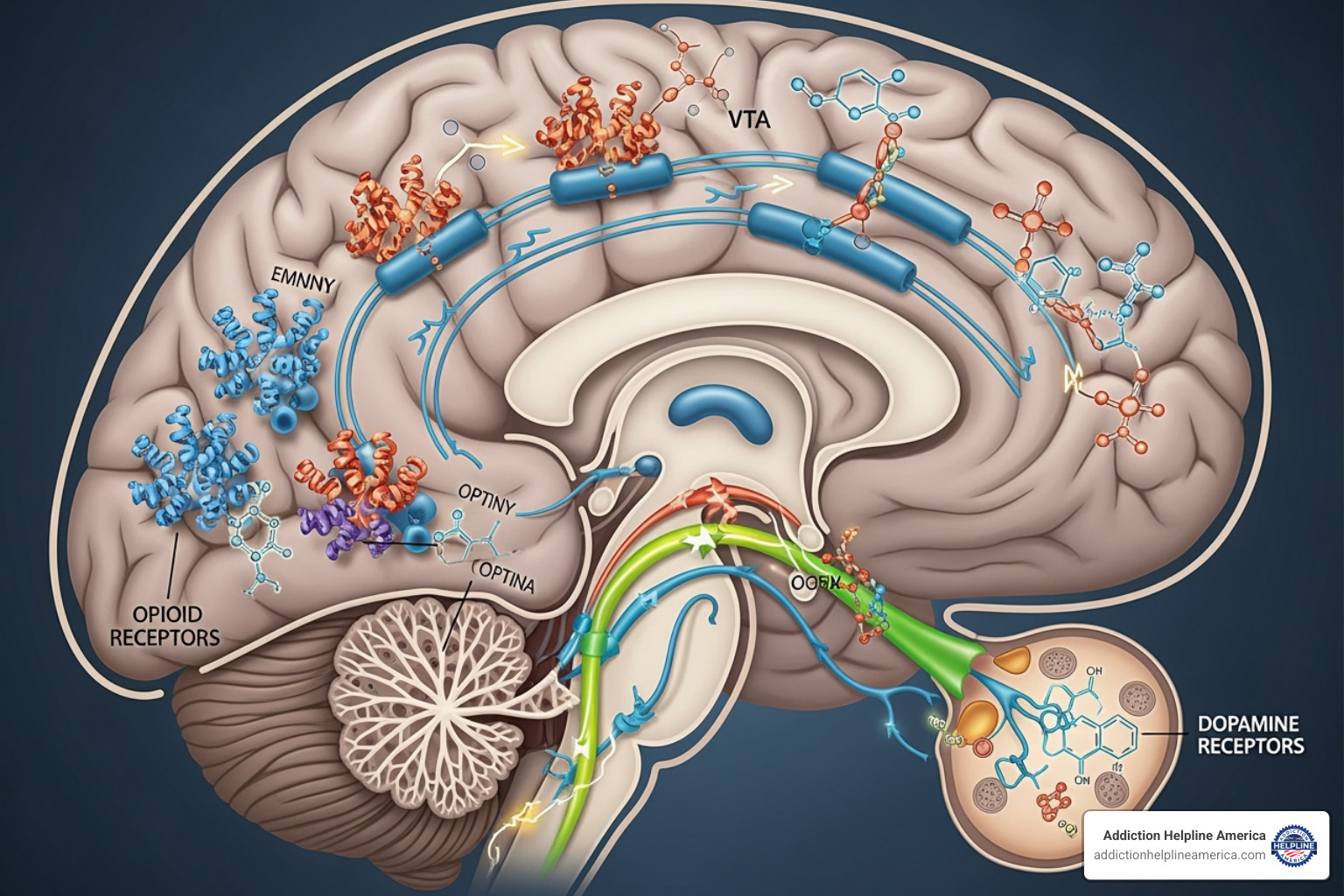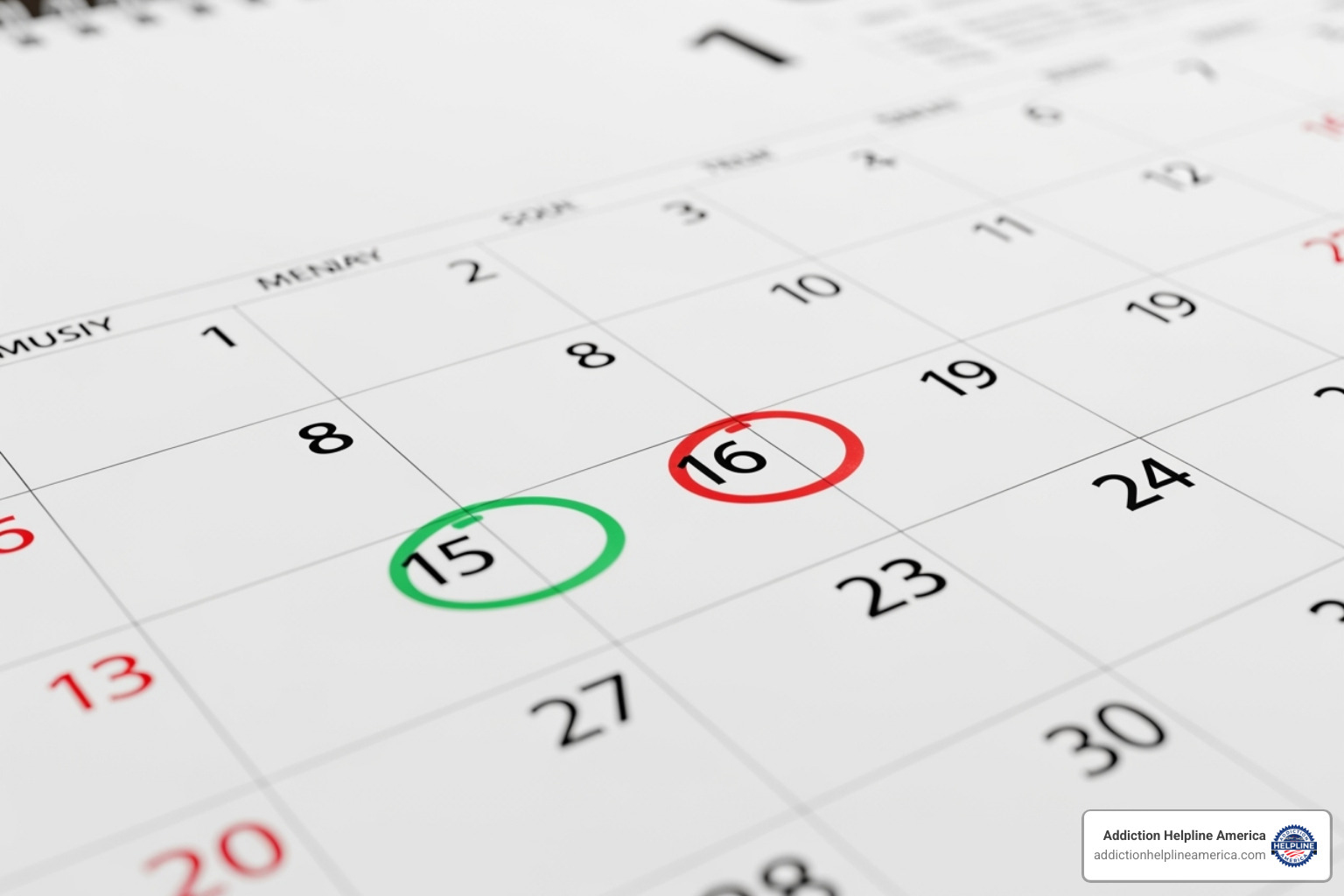Your Journey to a Healthier Life Starts Here
Free Insurance Verification
Verify Your Treatment Coverage
Verify Your Treatment Coverage
Vicodin Detox is the process of safely clearing hydrocodone from your body under medical supervision while managing withdrawal symptoms. Here’s what you need to know:
Key Facts About Vicodin Detox:
Vicodin was created for pain relief, but its use can quickly lead to dependence. The hydrocodone in Vicodin alters brain chemistry, creating euphoria and relaxation. Over time, the brain adapts, and the body needs the drug just to feel normal—a state known as physical dependence. When you stop taking it, the body reacts with severe withdrawal symptoms.
The statistics are alarming: Vicodin abuse has quadrupled over the past decade, with millions using it for nonmedical purposes. But withdrawal doesn’t have to be a barrier to recovery. With proper medical care, detox is manageable, safe, and more comfortable.
At Addiction Helpline America, we connect people with evidence-based treatment resources 24/7. This guide will walk you through every stage of Vicodin detox and toward lasting recovery.

To understand Vicodin detox, it helps to know how the drug affects your body and brain. This knowledge can clarify the path toward recovery.
What is Vicodin?
Vicodin is a prescription painkiller combining hydrocodone (a semi-synthetic opioid) and acetaminophen (Tylenol). While effective for pain, the hydrocodone component makes it highly addictive.
How Vicodin Works in Your Brain
Hydrocodone binds to opioid receptors in the brain, triggering a flood of dopamine that causes euphoria and relaxation. It also slows the central nervous system, which relieves pain.

Take the first step towards a healthier life! Call now to connect with our compassionate team and start your recovery journey today. Your path to healing awaits!
Our recovery specialists are available 24/7 to provide support, and all calls are confidential and free. Reach out anytime – we’re here to help!

With regular use, the brain adapts by reducing its own natural opioids and opioid receptors. This process, known as the neurobiology of opioid dependence, is the biological reason quitting is so difficult.
Tolerance and Physical Dependence
This brain adaptation leads to two key issues:
While physical dependence can occur even with prescribed use, addiction (Opioid Use Disorder) involves compulsive drug-seeking despite negative consequences.
Signs of Vicodin Abuse
Vicodin misuse can manifest in various ways:
The rise in Vicodin prescriptions has led to a corresponding increase in misuse. These statistics represent real people who often started with a legitimate prescription and became trapped. The good news is that Vicodin detox and recovery are achievable with the right support.
Understanding the withdrawal process can reduce its power over you. Withdrawal is your brain and body recalibrating to function without Vicodin. While uncomfortable, it’s a necessary step toward recovery.
The primary risks of unmanaged withdrawal are not from the symptoms themselves but from complications. Severe vomiting and diarrhea can lead to dangerous dehydration and electrolyte imbalances, especially for those with pre-existing health conditions. The biggest risk, however, is overdose. After detox, your tolerance is significantly lower. Relapsing with a previously “normal” dose can be fatal. This is why Vicodin detox under medical supervision is essential for safety.
Common withdrawal symptoms include:
Vicodin detox follows a predictable pattern due to hydrocodone’s short half-life of 3-4 hours, per FDA drug label information.

Your individual timeline will depend on factors like the duration and dosage of Vicodin use, your overall health, and whether you have co-occurring mental health conditions.
After the acute phase, some people experience Post-Acute Withdrawal Syndrome (PAWS), which involves lingering psychological and emotional symptoms like anxiety, depression, insomnia, and cravings that can last for weeks or months. This is a normal part of the brain’s healing process.
PAWS is manageable and improves over time with the right strategies:
Experiencing PAWS is not a sign of failure; it’s a sign of healing. With patience and support, these symptoms will diminish. Addiction Helpline America is here 24/7 to connect you with resources to manage withdrawal and PAWS effectively.
Attempting Vicodin detox alone is dangerous. Professional medical support is essential for safety, comfort, and success. Medical teams monitor vital signs, manage complications like dehydration or high blood pressure, and provide medications to ease the brutal symptoms of withdrawal. This support makes the experience manageable and significantly reduces the risk of giving up and relapsing. A professional setting also provides a structured, substance-free environment during your most vulnerable period.
Choosing Your Detox Setting
Professional Vicodin detox is available in different settings:
For opioid withdrawal, medical detox using FDA-approved medications is strongly recommended over “natural” detox approaches, which are best used as supplementary, not primary, treatments.
Modern detox combines medical intervention with supportive care. Medication-Assisted Treatment (MAT) is the gold standard, as established by the ASAM National Practice Guideline for Opioid Use Disorder.
Medication-Assisted Treatment (MAT) MAT uses medications to stabilize the brain and manage withdrawal.
Supportive Care Comprehensive support is also vital. This includes ensuring proper hydration and nutrition (with IV fluids if necessary), and incorporating holistic therapies like gentle exercise, meditation, and acupuncture to manage stress and discomfort.
The process is structured to ensure your safety and prepare you for long-term recovery.
Completing Vicodin detox is a courageous first step, but it is not the final one. Detox addresses physical dependence, but lasting recovery requires addressing the psychological and behavioral patterns behind addiction. Without follow-up treatment, relapse is common.


Take the first step towards a healthier life! Call now to connect with our compassionate team and start your recovery journey today. Your path to healing awaits!
Our recovery specialists are available 24/7 to provide support, and all calls are confidential and free. Reach out anytime – we’re here to help!
This next phase is about building a foundation for a life free from Vicodin. Addiction Helpline America connects you with programs that provide this crucial continuum of care.
Comprehensive Treatment Options
Cornerstones of Recovery
Recovery is an ongoing journey of growth. At Addiction Helpline America, we are here to help you find the resources you need to build a new, healthy life.
Taking the first step toward Vicodin detox brings up many questions. Here are answers to some of the most common concerns.
The acute phase of Vicodin detox, when physical symptoms are most intense, typically lasts 5 to 7 days. Symptoms begin 6-12 hours after the last dose, peak between days 1-3, and then start to subside. However, psychological symptoms like anxiety, depression, and cravings can linger for weeks or months in a condition known as Post-Acute Withdrawal Syndrome (PAWS). This is a normal part of the brain’s healing process and is manageable with ongoing support and treatment.
Yes, it can be. While rarely fatal on its own, withdrawal can lead to dangerous complications. Severe vomiting and diarrhea can cause life-threatening dehydration and electrolyte imbalances, especially for those with other health issues. The most significant danger is the high risk of a fatal overdose if you relapse after detox. Your tolerance to opioids will be dramatically lower, and a previously normal dose can become lethal. Medical supervision is crucial to manage these risks safely.
We strongly advise against attempting Vicodin detox at home without medical supervision. There are three main reasons:
At Addiction Helpline America, we can connect you with professional detox programs to guide you safely and comfortably. We’re here to help you find personalized addiction treatment help today, 24/7, with free, confidential guidance every step of the way.
Deciding to start Vicodin Detox is a brave and life-changing choice. As this guide has shown, withdrawal is a challenging but manageable process with professional medical support. While acute symptoms typically subside within a week, the journey to lasting recovery requires addressing the underlying causes of addiction.
Remember these key points:
Addiction Helpline America is your partner in this journey. We provide free, confidential, and personalized guidance 24/7, connecting you to a nationwide network of vetted treatment centers. We take the time to understand your unique needs to help you find the right program.
If you or a loved one is struggling with Vicodin dependence, don’t wait. The moment you reach out, healing can begin. Your future, free from addiction, is waiting.
Find personalized addiction treatment help today. We’re here, ready to help you take that next brave step.
Are you or a loved one struggling with addiction? Call today to speak to a treatment expert.
Calls to any general helpline will be answered or returned by one of the treatment providers listed, each of which is a paid advertiser:
Our helpline is available 24 hours a day, 7 days a week at no cost to you and with no obligation for you to enter into treatment. We are committed to providing support and guidance whenever you need it.
In some cases, Addiction Helpline America charges our verified partner a modest cost per call. This fee helps us cover the costs of building and maintaining our website, ensuring that we can continue to offer this valuable service to those in need.
Calls to the general helpline will be answered or returned by one of the listed treatment providers, all of whom are paid advertisers.
By using the helpline, you agree to the terms of use. We do not earn any commission or fee based on the treatment provider selected by the caller, and there is no obligation to pursue treatment.
This service is not affiliated with Alcoholics Anonymous World Services, Inc.